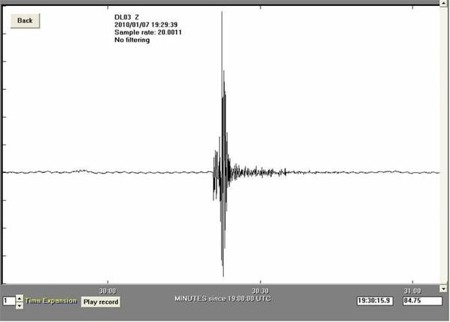|
|
Seismic vibrations at local school
12.01.10
Earthquake strikes
Inishowen peninsula
by Linda McGrory
INISHOWEN has been hit by an earthquake measuring
1.6 on the Richter Scale, it's been confirmed. The
School of Cosmic Physics at the Dublin Institute for
Advanced Studies (DIAS) said the minor tremor struck
at 7.30pm last Thursday with the epicentre located
at Bridgend in the south of the peninsula. A number
of people in the Inishowen and Fanad peninsulas
reported hearing a loud bang similar to a
thunderclap, followed by a tremor. Some residents in
the Desertegney area said it sounded like a rattle
of thunder that seemed "to roll along Lough Swilly".
Others, in Kerrykeel, fled their homes until they
realised the tremor posed no threat to their safety.
The earthquake was recorded at St Egney's national
school in Desertegney which hosts a seismometer for
the DIAS as part of the Seismology in Schools
Programme. |
 |
|
"On Friday, January 8,
it was confirmed that the school had accurately
recorded and identified the earthquake, the first
case where a participant in the Seismology in
Schools Programme has verified an indigenous
earthquake," said LYIT information technology
manager, John O'Raw, on behalf of the school. "As
science is an important subject in the new revised
curriculum for primary schools, the staff and pupils
of St. Egney’s are delighted to avail of this
opportunity to bring the science of seismology into
the classroom. "In recent years the school has put a
huge emphasis on practical science in the classroom
and in the local environment, and has participated
in national initiatives such as the Greenwave and
Discovery Science programmes," he added. Mr O'Raw
said DIAS in association with LYIT were currently
doing the preparatory work for the first national
seismometer in Donegal - likely to be located at
Inch Island. Meanwhile, Dr Thomas Blake of the
School of Cosmic Physics said several people in
Donegal had already filled in an online
questionnaire on the DIAS website outlining details
about the incident. He said Donegal was one of the
counties most at risk of earthquakes in Ireland due
to several fault lines extending from Scotland to
North Donegal. Thursday evening's tremor was picked
up by all the seismic recording stations in Northern
Ireland and Scotland. “North Donegal and from
Wexford across the Irish Sea are the areas most
likely to be associated with earthquakes in
Ireland," said Dr Blake. "Earthquakes are nature's
way of releasing a build-up of stress in the rocks.
They are completely independent of the weather and
have nothing to do with this ongoing cold spell."
The biggest earthquake to hit Ireland registered 5.4
on the Richter Scale and occurred off Wexford in the
Irish Sea on July 19, 1984. North Donegal also
experienced an earthquake on February 21, 2008, with
an estimated magnitude of 2.4 and its epicentre near
Buncrana. This was the largest earthquake ever
recorded on land in Ireland. Dr Blake said while
this week's tremor in Inishowen was small, he was
keen to find out as much as possible about it. He
was also looking forward to receiving the data from
the seismometer in Desertegney and the ones located
in schools in Stranorlar and Bundoran. Meanwhile,
anyone who experienced the tremor is invited to fill
in the questionnaire on the website
www.dias.ie . |
|

